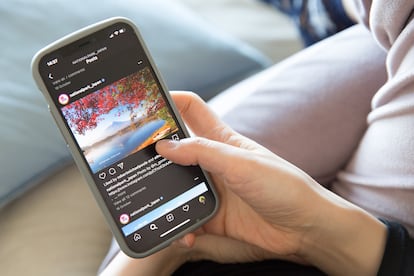Social media ads trick users: This is how advertising sneaks in on Instagram

A new study reveals that people cannot easily detect ads because platforms have managed to camouflage commercial messages as personal content.

And there may be more of those ads than we realize. A group of scientists has discovered that people don't detect them as well as previously thought. And no, it's not that people are worse at understanding ads. It's that platforms have managed to make them more integrated, according to the new study published in the journal Frontiers and led by researcher Maike Hübner . "I have nephews, and when I observed how today's children and adolescents grow up with a phone in their hands, I noticed how early they are exposed to fake news and advertising on social media. That was the main motivation for the analysis," says Hübner, of the University of Twente (Netherlands).
Hübner shared her concerns with other colleagues and students. To her surprise, many of them were also unclear about how much advertising they saw on a daily basis. Some even responded, "Well, I like to be up to date; I want to feel like I belong." Given the difficulty people have in distinguishing between real ads and posts, this expert decided to study why this continues to happen.
The scientists invited 152 volunteers who are regular Instagram users to view one of three simulated Instagram feeds. Each feed consisted of 29 posts: eight ads and 21 organic posts. They were asked to imagine the feed was their own and to browse it as they normally would.
Hübner and his team recorded eye movements and also assessed the time spent on the ads. After each session, the scientists interviewed the participants about their experience. The results of the analysis, published this Wednesday, reveal that most of the volunteers were surprised to discover how many ads they had missed. “They were very confident in their ability before the experiment,” he says.
Participants focused on details like logo design, high-quality images, or "Buy Now" buttons before realizing the information was real. Researchers found that the ads often went unnoticed, but if people realized the content wasn't organic, many stopped engaging with the post. Eye-tracking data suggests that those who paid more attention to calls to action (such as a sign-up link, for example) may be using these elements as a way to identify paid messages.
This was less likely to occur with ads that were better integrated and in a format typical of organic content. If the advertising signals weren't immediately noticed, they garnered similar engagement levels to content that is shared naturally.
The study, however, is not without its critics. Jean Éric Pelet, professor of advanced digital marketing and author of the book Consumer Behavior: Understanding Consumers in a Digital Landscape (Kogan Page, 2025) , notes that “important methodological details are missing,” such as measurement scales, to thoroughly evaluate the results. Still, he acknowledges the value of the work. “It clearly shows how digital interfaces shape consumer behavior,” he emphasizes. Especially, he says, when it comes to what he calls “hidden advertising,” or embedded messages that are difficult to detect but very easy to absorb.
On that point, the authors of the new study plan to expand their research to other platforms, such as TikTok or YouTube, where the lines between content and advertising are even more blurred. Social media platforms like Instagram have abandoned traditional banner ads to blend in with organic content because some users have learned to overlook ads in this format. Some people have managed to develop visual or persuasive literacy, that critical ability to recognize and analyze covert advertising messages. But this is not the case with younger people or those who follow trends without question.
Ads are spread throughout the feed
The abandonment of banner ads as a marketing strategy has forced advertising to reinvent itself. Now, social media ads can appear in the middle of posts, blend in with regular content, and even disguise themselves as entertainment. Users today, however, don't just ignore them. They engage selectively, drawn to aesthetic design, humor, and fluid narrative. Maike Hübner says what they observed in their analysis is nothing less than an evolution of this so-called " banner blindness."
These features generate what Jean Éric Pelet describes as a “flow state,” where the user remains captivated—even by promotional content—without realizing it. “I myself have seen entire ads knowing exactly what they are doing,” he said, referring to a recent Google campaign about its AI-powered video technology, VEO 3.
Hübner also compares this phenomenon to the impact of unrealistic beauty standards circulating on social media. The shift in perception occurs gradually, almost undetectable, and is difficult to identify until it has already left its mark. It's subtle, convenient, and that's why it's so effective. "Perhaps the answer lies in educational strategies or specific changes in platform design," says this researcher.
Advertising legislation falls short
Regulations on social media advertising can vary across nations. In regions such as the European Union (EU) and countries like Spain, China, and the United States, there are specific legal frameworks addressing online advertising, focusing on the protection of minors, political advertising, and the promotion of certain products or services. Maike Hübner and Jean Éric Pelet agree that the platforms aren't doing enough. "They comply with the regulations, the labels are there; but our study shows that they are not effective in practice," explains Hübner.
The Digital Services Act , which came into force across the EU in February 2024, requires greater transparency from online platforms . They must label ads and maintain “a repository with details about the paid advertising campaigns running on their online interfaces.” The reality is that people don’t intentionally ignore labels; they simply “don’t see them.” “Transparency should go beyond simply placing a label; people browse social media in a relaxed, automatic state ,” he notes.
Pelet takes a more radical view. He has taught in China and has experienced firsthand the digital landscape of platforms like WeChat and TikTok. “They collect as much data as they can. So no, they don't seek to be transparent,” he notes. Social media infiltrates what he calls “leisure time,” or those brief, unstructured moments when people check their phones in bed or on public transport. It's during these micro-moments that “advertising becomes most powerful.”
Another way to attract users and promote subtle brand messages is through the charisma of celebrities or influencers . Little Red Book , a Chinese social network promoted by soccer player Kylian Mbappé, is an illustrative example. Although little known outside of that country, it could soon reach global markets. For Pelet, this is a case of how public figures become vehicles to attract users and position brands without the advertising message being perceived as such.
“It’s not that advertising is bad—platforms and creators need revenue—but users should be able to make an informed decision, just as they used to be when TV clearly marked the start of an ad block,” Hübner concludes. Now, as we quickly browse social media feeds, between filters and 15-second videos, the fine line between content and advertising becomes increasingly blurred.
Constanza Cabrera , El Pais Spain






